City trip Paris
Mostly 25-40 years-old singles lives in the city
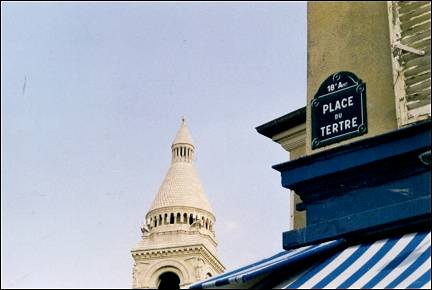
|
Visiting Paris highlights: Les Tuileries, Dôme des Invalides, La Défense, Montmartre, Sacré Cœur, Place du Tertre, Place des Abbesses, Montparnasse, Notre Dame, Eiffel Tower, Quartier Latin. And the three triumphal arches that fit each other like Matroshkas: Arc de Triomphe du Carrousel, Arc de Triomphe, La Grande Arche.
Travelogue & photos: Angélique Woudenberg
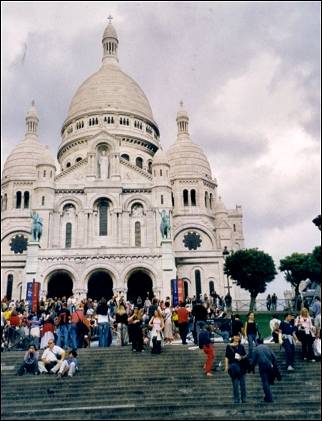
|
Our hotel is in a working-class neighborhood in the 18th Arrondissement, near the Sacré-Coeur. There are lots of African (clothes) stores, bazars, islamic butcher stores, groceries and cosmetics shops. It's a real immigrant neighborhood. Many people here are from the "Maghreb" in North-Africa or from sub-Saharan Africa.
While preparing for our trip, we read on the internet that tourists are discouraged from traveling with subway line 4. But the only subway near our hotel is number 4. We also read that we should avoid subway station Barbès Rochechouart, but that isn't possible if we want to take the subway.
We walk to the end of the Boulevard Barbès and take the long Boulevard de Rochehouart and Boulevard de Clichy with again many African stores. Souvenirs are cheap here and so this is where we'll buy them by the end of the week.
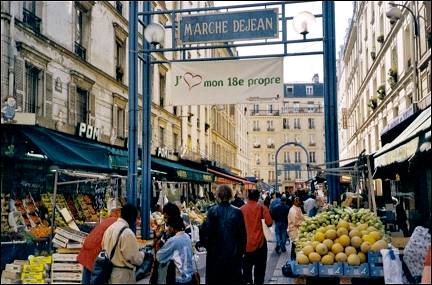
|
We're on our way to the Moulin Rouge. In one of the cross streets of the long boulevard we see the Sacré-Coeur in the distance. We almost miss it because of the high rises, but when we see a large group of tourists appear from subway station Anvers, we follow them to see where they're going. And then we see the Sacré-Coeur.
The cross street isn't very steep, but when we see the stairs we'll have to climb to get up, we decide to visit the Sacré-Coeur tomorrow, when we're rested.
We walk back and start looking for the Moulin Rouge. It's a long walk. The souvenirs shops and restaurants on the boulevard make place for sex shops, night clubs and sleezy joints. Then, finally, we see the sails of the Moulin Rouge turn, something they only do at night.
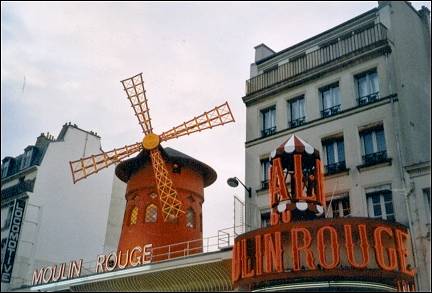
|
Opposite the Moulin Rouge and subway station Blanche we see a tourist train that rides to the butte (hill) Montmartre and stops on the way at the Sacré-Coeur, the Place du Tertre and Place des Abbesses.
The stores are closed now, only nightclubs, bars and brasseries are open. It's getting quiet in the streets and the homeless people start looking for a place to sleep.
Our hotelroom is on a wide boulevard with four traffic lanes. Our sleep is disrupted by yelling Africans, cars and screaming police and ambulance sirens.
Napoleon was buried in seven caskets
Arc de Triomphe du Carrousel, La Défense, Dôme des Invalides
We haven't slept and need a hearty breakfast. Next to the hotel is a café (which belongs to the hotel) where we have breakfast.
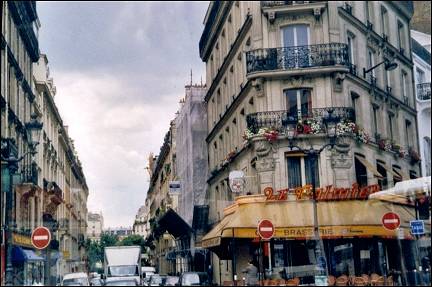
|
The café looks good, but their breakfast is not: we almost break our teeth on the baguette and the fruit juice is diluted with lots of water. No cold cuts, cheese or little containers of jam. Only one glass jar of jam, which everyone uses with their own utensils.
In the morning we take a city tour with a Dutch speaking guide. The guide tells us about the Paris sewer system. Twice a day the sewers let in clean water from the Seine river. The rest of the week we see water flowing along the streets in the morning and evening. Sanitation department workers sweep the dirt away afterwards. Doesn't seem handy in the winter,when it freezes.
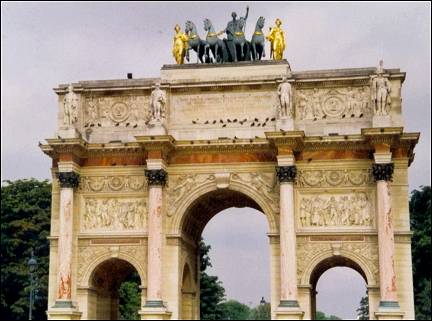
|
Paris has the largest underground sewer system in the world, over 2200 km long. If we're interested, we can take a tour of the sewers. There even is a sewer museum.
But when the guide continues to tell us that in Paris more rats live in the sewers (over 2 million) than people above ground, we're no longer interested. The rats are not exterminated because they're part of the ecological system: they eats tons of garbage every day.
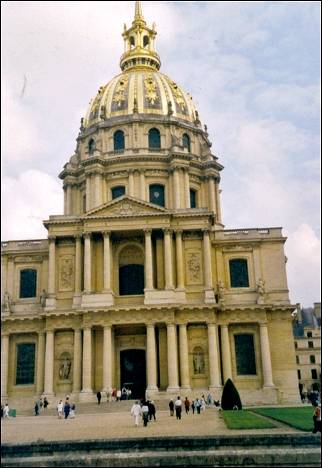
|
The guide also tells us about the system of arrondissements. Paris is divided in 20 arrondissements (neighborhoods) and every neighborhood has its own mayor and town hall. Since 1977 Paris also has a city mayor, who has a lot of power. The street signs show in which arrondissement you are.
We drive along the left and the right banks of the Seine. People here say: "I live on the left bank, because there I think. I also live on the right bank, because there I spend my money."
On the left bank in the south part of the city are universities like the Sorbonne; here the intellect reigns. On the right bank, to the north, business is conducted and here are the most expensive stores: Christian Dior, Nina Ricci and Chanel. We also see a Valentino store.
The guide tells us about social life in Paris. In the city center are mainly expensive studios and one bedrooms. Because of lack of space one does not entertain guests at home, but meets in one of the 13.000 cafés in Paris.
The city is mainly populated by singles between 25 and 40 years old. Families with children make up only 18 percent of the population.
Real estate within the ring is ridiculously expensive. A square meter costs € 500 on average. The median income is € 1100 per month. So families move to the cheaper suburbs.
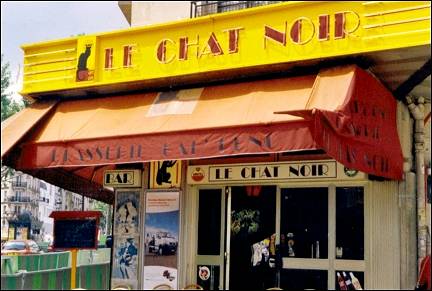
|
We get off the tour bus at Carrousel du Louvre, an underground mall with a preserved part of the old city walls. Here we also see the upside-down glass pyramide which provides daylight for the mall.
Back on ground level, above the mall, we walk over a sandy square toward the Arc de Triomphe du Carrousel. This first triumphal arch was built to memorialize Napoleon's victories. This triumphal arch fits in the big Arc de Triomphe on the Champs Elysees, which in its turn fits in La Grande Arche in the office neighborhood La Défense which we'll visit later.
Behind the Arc de Triomphe du Carroussel is the Tuileries, a park with beautifully designed gardens, where we take a short walk.
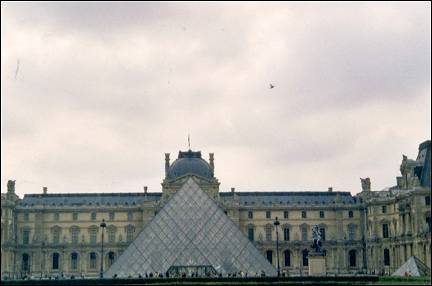
|
At the other side of the park is a fun fair on the Rue de Rivoli. At the end of that street is a gilded statue of Jeanne d'Arc. Once a year right-wing extremists gather here.
In the center of the park we see in the distance the obelisk on the Place de la Concorde and the big Arc de Triomphe on the Champs Elysees.
The Louvre, the Arc de Triomphe du Carroussel, Les Tuileries, the Place de la Concorde, the Arc de Triomphe and La Grande Arche are all positioned in one straight line.
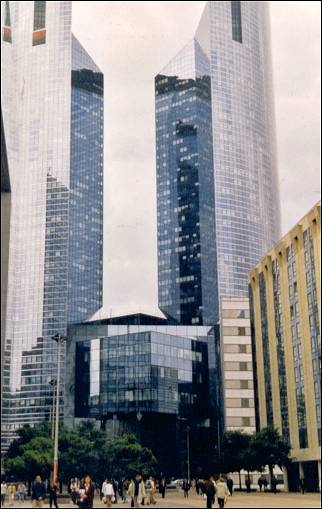
|
We stop to take pictures of the Dôme des Invalides. Originally it was meant to be a mausoleum for members of the royal family, but was used to house invalid soldiers. Now it is Napoleon's mausoleum. Napoleon died in 1821 on the isle of St. Helena and put in his will that he "wanted to be buried between my beloved people, on the Seine." In 1840 his remains were brought here in seven caskets. His heart and entrails are in a silver vaze. The guide tells us that it was customary to bury kings in three parts. One casket for the heart, one for the entrails and one for the body.
We drive along the grandstand where President Jacques Chirac will witness a military parade for the national holiday tomorrow.
And on we go to the office neighborhood of La Défense, where we admire La Grande Arche.
Yesterday evening we saw souvenirs and picture postcards with a black cat on them and the words "Le Chat Noir." We also saw a brasserie with this name on the Boulevard de Clichy. In our travel guide we can't find much about this black cat, just that he was a big hit in the 19th century cabarets of Montmartre. Unfortunately the French hardly speak English and our knowledge of French has deteriorated too much to be able to have a real conversation.
Fake painters just color in the drawings
Montmartre, Sacré Cœur, Place du Tertre, Place des Abbesses
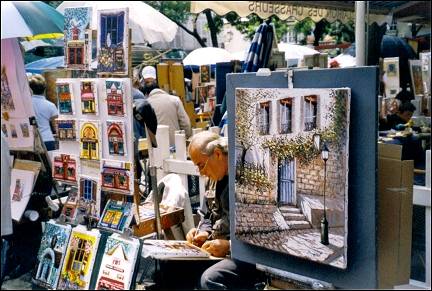
|
In the afternoon we take the tourist train opposite the Moulin Rouge to the painter's neighborhood of Montmartre. Under loud carnival music we are taken to the butte (hill) of Montmartre.
We get off at Place du Tertre where we break our necks over tourists and would-be painters. We only see a few painters who are drawing good portraits. Befor we went to Paris we read that the drawings are made in Asia and that the "painter" only has to fill in the colors. We don't know if this is true, but it's clear that there are a lot of fake painters here.
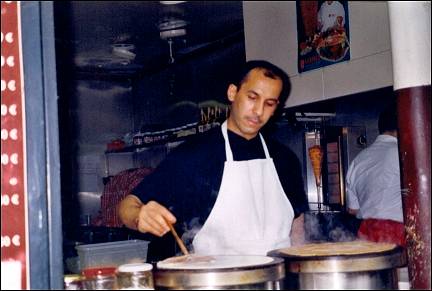
|
It's time to sit down on a terrace to watch people. Prices are shockingly high around touristic highlights.
A few people walk by eating some kind of very thin pancake; it looks apealing. These pancakes are called "crêpes" and are the street snack of preference. There are different kinds, but we first try the "crêpe naturel" with sugar. The crêpe is fried on a hotplate and then folded four times to make a conic shape.
We walk down and enjoy the wonderful view of Paris. The Tour de Montparnasse and the Eiffel Tower stand out clearly.
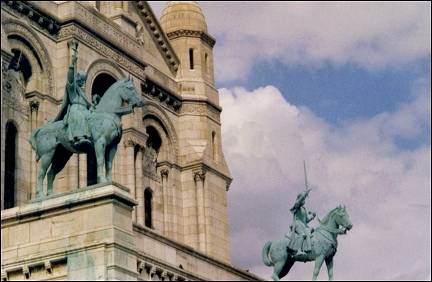
|
Thanks to the tourist train we only have to climb a few steps to visit the "Sacred Heart", the Sacré-Coeur. It has pretty stained glass windows and rose windows. Inside the cupola is a beautiful Christ fresco. The cupola is the second highest (after the Eiffel Tower) spot in Paris.
Outside we take pictures of a stained glass window just past the entrance and of the Louis IX the Saint and Jeanne d'Arc statues in front of the main entrance.
We take the train back. Via steep streets we reach first the Place des Abbesses and then the last stop Place Blanche opposite the Moulin Rouge.
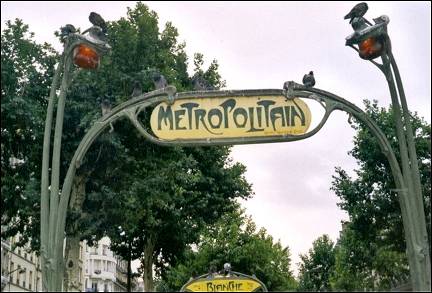
|
In the evening we visit the Tour Montparnasse, the highest skyscraper of Europe. We don't go up: too high (210 meters) and you have to pay to take the elevator to the top to enjoy the view.
We save our money to be able to sit on one of the very expensive terraces. Tonight there are several parties in the city - a tradition on the night before Quatorze Juillet (July 14).
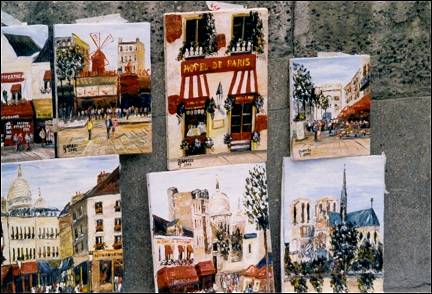
|
We read in the free newspaper Metro (which we also have in Holland) that tonight there's a public ball on the Place de la Bastille where you can dance the tango, salsa and merengue and also that there will be rock bands on the square in front of city hall (Hôtel De Ville).
It's very crowded. The guide explained this morning that partying takes place all week long, not just on the weekends. This is because there are so many young people in Paris. But tonight it is more crowded than usual because everyone has the day off tomorrow. Every city and town in France has a public ball on the night before July 14.
In the evening all hell breaks loose. Officially fireworks are allowed only tomorrow night, but around our hotel we already hear firecrackers tonight.
Nationale Holiday Quartorze Juillet
Choppers and fighter jets fly over the Arc de Triomph
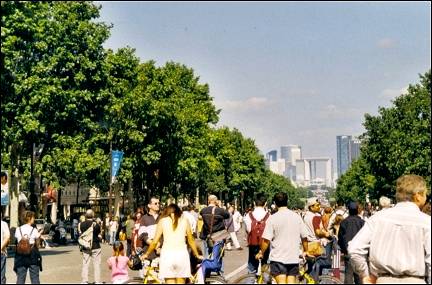
|
We skip breakfast and go to subway station Château Rouge. Getting around by subway is fast and easy in Paris. We only have to find our destination on the map, trace the line and find the final station to make sure we get on the right subway line.
At Barbès Rochechouart we have to change to the blue line number 2, direction Porte Dauphine. We get off at Charles de Gaulle Etoile to attend the military parade on the Champs Elysees.
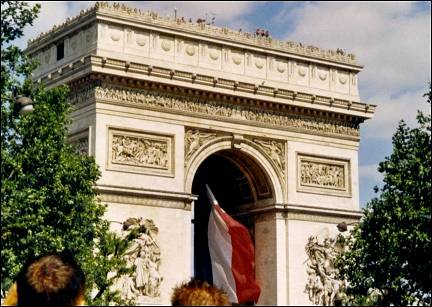
|
On the subway we're treated to live music by gypsies. Nobody gives them money. After every stop they get out and move to the next car. Maybe they'll have more luck there.
It's crowded at the Arc de Triomphe and there are many armed soldiers, police and military vehicles in the street.
The Arc de Triomph is closed off with crash barriers. The parade started at 9 AM and will go on to 12. There's a lot of police. Two years ago, an extremist wanted to assassinate Jacques Chirac on July 14, that is why security has been intensified.
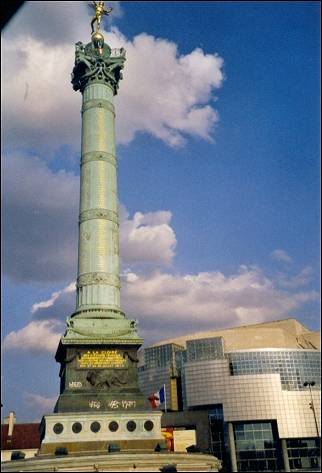
|
We are on the wrong side of the Arc de Triomph and follow the crowd to find a spot on the Champs Elysees. A formation of choppers flies over the Arc de Triomph. The noise is deafening, but it looks cool. The choppers arrive from the direction of La Grande Arche, which we can see quite clearly today.
It's busy along the Champs Elysees. Military vehicles drive by and people wave French flags.
Quatorze Juillet is the annual celebration of the birth of the Republic. On this date the storming of the Bastille is remembered. The inhabitants of Paris lived in poverty and the already not overly popular king, Louis XVI, lived in wealth and luxury. The revolutionaries considered the Bastille a symbol of oppression, because there anti-monarchists were kept prisoners.
The Parisians stormed the prison and liberated the seven prisoners. Shortly afterwards the Bastille was demolished. According to tradition by an angry mob, but we have also read that it was done by a demolition company.
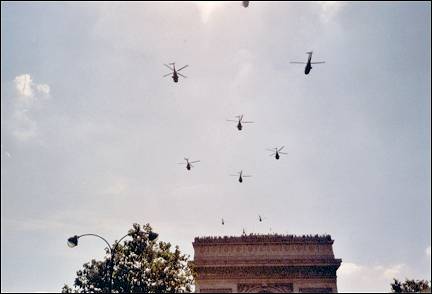
|
Two hundreds years after the storming of the Bastille the opera house "Opéra de la Bastille" was built, in 1989, on the Place de la Bastille. Where once the prison was, now stands a 50 meters high column, the Colonne de Juillet.
Because of the crowds we don't see anything of the parade. Close to 12 a squadron of fighter jets fly over the Arc de Triomphe at high speed, spraying le tricouloir: the colors blue, white and red of the French flag. And that's the end of the parade.
Arc de Triomphe and Eiffel Tower
A star of avenues, with at its heart the Place de L'Etoile
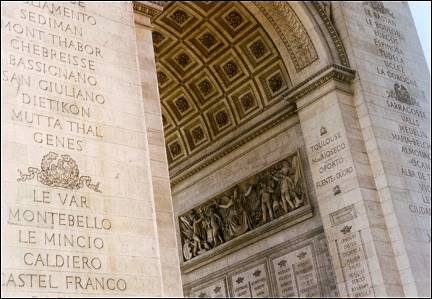
|
We push our way to the Arc de Triomphe. Traffic is allowed again and we risk our lives crossing the road. Later we see an underpass that takes you to the other side.
We look at the names of the soldiers. The underlined names died on the battlefield. Beneath the big triumphal arch is the tomb of the Unknown Soldier from the First World War. We look at the victories of Napoleon's army. Napoleon never saw the triumphal arch, he died in 1821 and the Arc de Triomph was finished only in 1836.
Around the Place de L'Etoile, where the Arc de Triomph is, we clearly see the straight avenues going out from it. Very neatly arranged. This Baron Haussman did a good job mid-nineteenth century. He designed a new Paris and a star of avenues around the Place de L' Etoile. On our map the "star" is clearly visible.
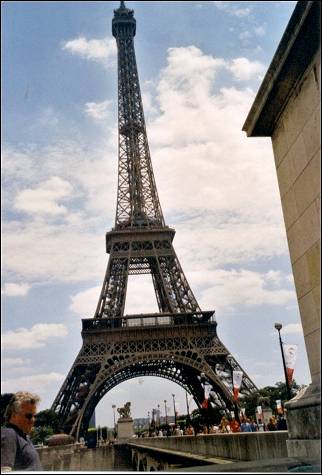
|
We take subway line 6 in the direction of Nation and get off at Bir-Hakeim to visit the Eiffel Tower. In the subway station a rasta is drumming fanatically. On the train is also live music. This time a guy who plays the saxophone.
We have to walk a while before we're standing underneath the 320 meters high Eiffel Tower. There's a long line for the elevator. If it weren't for the antennas on top of the Eiffel Tower, it would probably have been demolished a long while ago. The Eiffel Tower gets a new coat of paint every seven years and it takes a year to get the job done.
We walk via the Pont d'Iena and Palais de Chaillot (built for a world fair) through a park to subway station Passy. At La Motte Picquet we change to the dark yellow line in the direction of Gare d'Austerlitz.
We get off at Odéon and change to the number 4, direction Porte de Clignancourt. At the second stop we get off: Cité.
Between dusty bookcases sit beds
Notre Dame, Quartier Latin, Seine and bookstore Shakespeare
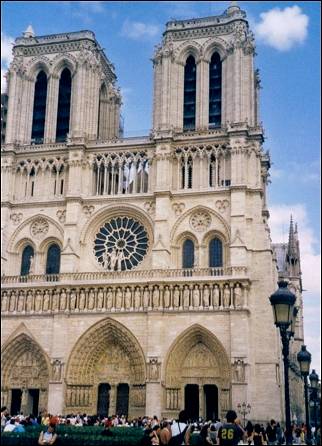
|
From subway station Cité we walk to the Notre Dame. In this church Napoleon crowned himself Emperor of France.
But first we visit Quatier Latin to sit on a terrace. We walk through narrow, lively streets with many foreign restaurants. On the Boulevard Saint Michel we have to look for a place to sit on a terrace, but finally we find one.
We walk along the Seine, with bookstalls everywhere, toward the Notre Dame. Yesterday the guide told us that if you want to rent a space to sell books here, you have to be a qualified librarian or have some other relevant degree. If you don't, you're put on a waiting list for seven years.
Lots of old, dusty books and pretty old maps. Unfortunately the (fake) "beach" on the Seine, "Paris Plage" doesn't open until July 20.
We visit the Shakespeare & Co. bookstore on 37, Rue de la Bûcherie nummer 37, near the Notre Dame.
We read that you can take a nap in this old bookstore. The beds are supposed to be hidden between bookcases. We look and yes, on the third floor we see some beds between bookcases. I have to make an effort not to sneeze. It's so dusty in here. The ancient proprietor unfortunately isn't there, but there are many students.
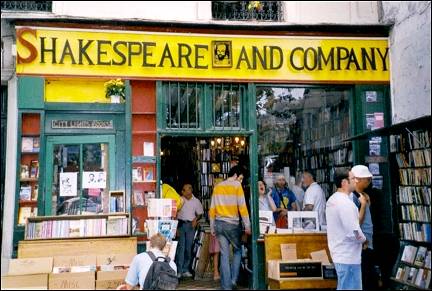
|
In front of the Notre Dame is a long line. At the top of the church we see the galery with the Chimères. They look like little devils with angel wings.
Because of the long line in front of the Notre Dame we miss Point Zéro. From this point all distances in France are measured.
In de Notre Dame we attend part of the Gregorian mass. This church is also decorated with stained glass and rose windows. We walk around the Notre Dame and sit down in the Jean XXIII Park directly behind it. Almost all benches are taken by lovers and elderly couples.
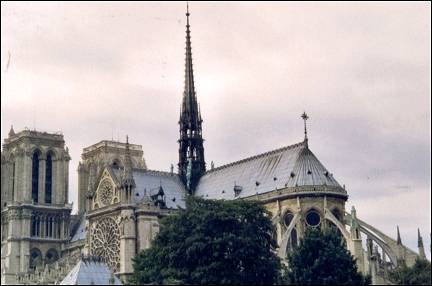
|
We walk along the Seine with the book stalls to the Hôtel de Ville (city hall). On the square in front of it people were hung on the gallows or executed in other ways in the past.
Near the city hall is Centre Pompidou. From subway stop Cité it's easy to visit different attractions: Notre Dame, Quatier Latin, Saint Chapelle, Conciergerie, Hôtel de Ville and Centre Pompidou are at walking distance.
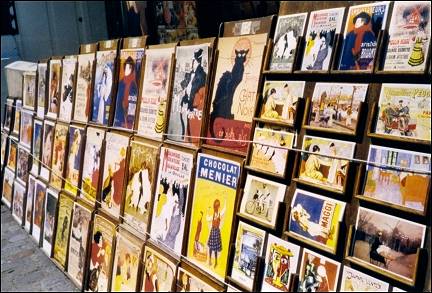
|
We forget to visit the Saint Chapelle and the Conciergerie. This last place was the prison where Marie Antoinette, Louis XVI's wife, was decapitated by the guillotine in 1793.
Balconies and a beautiful cupola
Boulevard Haussmann, Galerie Lafayette, Printemps
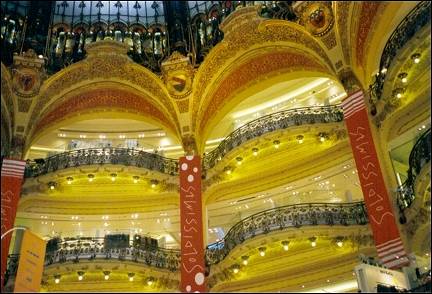
|
Before we drive back to Holland, we visit the big department store Galerie Lafayette on the Boulevard Haussmann. We want to see its beautiful balconies and cupola.
We don't shop, but walk on to the other department store on the Boulevard Haussmann, Printemps, for a pretty view of the city. On the tenth floor at the restaurant's terrace we enjoy the view, already saying goodbye to Paris.
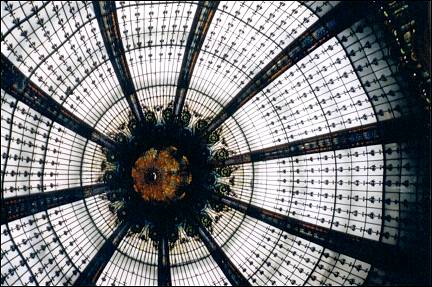
|
Our four days in Paris are over. We walked a lot and saw much. Next time we visit Paris we will visit the old Jewish quarter Le Marais, the Musée Carnavalet and the Louvre.